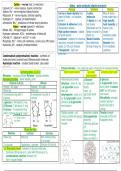Cation - +ve ion (lost 1+ electrons) Water – polar molecule (dipole structure)
Calcium Ca - nerve impulse, muscle contraction
2+
Physical Chemical Thermal
Sodium, Na+ - nerve impulse, kidney function` Ice has a lower density than A polar Many H bonds
Potassium, K+ - nerve impulse, stomatal opening water so floats - ice insulates molecule mean water has a
Hydrogen, H+ - catalyst, pH determination below it A dipole as e- are high specific
Ammonium, NH4+ - production of nitrate ions by bacteria Cohesive & adhesive bonds – not evenly heat capacity so
Anion - -ve ion (gained 1+ electrons) transpiration stream distributed so H is heats/ cools
Nitrate, NO3- - nitrogen supply to plants High surface tension – habitat delta +ve and O is slowly –
Hydrogen carbonate, HCO3- - maintenance of blood pH for pond skaters delta -ve maintains stable
Chloride, Cl- - balance k+ and Ca2+ in cells A solvent – medium for chemical Weak H bonds, environment
Phosphate, PO43- - forms cell membrane, nucleic acid, ATP, bones reactions, removal of metabolic but collectively Absorbs heat
Hydroxide, OH- - catalyst, pH determination waste, O2/ CO2 can dissolve strong in large no. from metabolic
Transparent – light can reactions
penetrate
Condensation (polymerisation) reaction – synthesis of
molecules forms covalent bond. Releases water molecule.
Hydrolysis reaction – covalent bond broken. Uses water
molecule. Polysaccharides – non-reducing sugars. Polymers of monosaccharides
Carbohydrates (C,H,O) Starch (plant seeds) Glycogen Cellulose (plant wall)
Monomer – monosaccharide. Polymer – polysaccharides (liver/muscle)
Monosaccharides – water soluble, polar Heteropolysaccharide 𝛼 Glucose β glucose
Glucose C6H12O6 Ribose Amylose – chain of 𝛼 by 1,4 glycosidic 1,4 glycosidic bonds.
Hexose - 6C sugar Pentose - 5C sugar 1,4 glycosidic bonds bonds Every other β rotates
Reducing Reducing that coil many 1,6 180° (so OH groups
6 membered ring with 5 5 membered ring with 4 Amylopectin – chain of 𝛼 glycosidic bond cant react)
Carbons carbons by 1,4 glycosidic bonds branches Microfibrils (straight
𝛼 glucose = OH below C1 ring joined by 1,6 glycosidic chains) held by h
β Glucose = OH above C1 ring bond branch. bonds that stop it
Fructose – 5-membered ring coiling.
with 4 Carbons Slightly soluble – coil Insoluble & stable Tensile strength
Tobut a 6C
draw 𝛼 sugar.
H = Down, down, means outside OH groups Glycogenolysis – Insoluble-no free OH
up, down form H bonds enzymes Staggered ends
Smaller hydrolyse glucose
off
Disaccharides Large & compact
Maltose Lactose Sucrose store of energy
Reducing Reducing Non-reducing (due Does not affect ᴪ
to fructose)
2 𝛼 glucose β galactose, 𝛼 glucose Glucose & fructose
1,4 Glycosidic bond – between 2 glucose molecules.
- Carboxyl (OH) group on C1 joins with OH group on C4
- condensation reaction releases H2O
- form ‘oxygen bridge’




